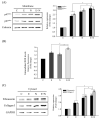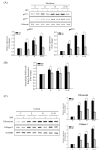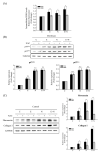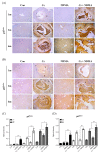The Overactivation of NADPH Oxidase during Clonorchis sinensis Infection and the Exposure to N-Nitroso Compounds Promote Periductal Fibrosis
- PMID: 34071467
- PMCID: PMC8227395
- DOI: 10.3390/antiox10060869
The Overactivation of NADPH Oxidase during Clonorchis sinensis Infection and the Exposure to N-Nitroso Compounds Promote Periductal Fibrosis
Abstract
Clonorchis sinensis, a high-risk pathogenic human liver fluke, provokes various hepatobiliary complications, including epithelial hyperplasia, inflammation, periductal fibrosis, and even cholangiocarcinogenesis via direct contact with worms and their excretory-secretory products (ESPs). These pathological changes are strongly associated with persistent increases in free radical accumulation, leading to oxidative stress-mediated lesions. The present study investigated C. sinensis infection- and/or carcinogen N-nitrosodimethylamine (NDMA)-associated fibrosis in cell culture and animal models. The treatment of human cholangiocytes (H69 cells) with ESPs or/and NDMA increased reactive oxidative species (ROS) generation via the activation of NADPH oxidase (NOX), resulting in augmented expression of fibrosis-related proteins. These increased expressions were markedly attenuated by preincubation with a NOX inhibitor (diphenyleneiodonium chloride) or an antioxidant (N-acetylcysteine), indicating the involvement of excessive NOX-dependent ROS formation in periductal fibrosis. The immunoreactive NOX subunits, p47phox and p67phox, were observed in the livers of mice infected with C. sinensis and both infection plus NDMA, concomitant with collagen deposition and immunoreactive fibronectin elevation. Staining intensities are proportional to lesion severity and infection duration or/and NDMA administration. Thus, excessive ROS formation via NOX overactivation is a detrimental factor for fibrogenesis during liver fluke infection and exposure to N-nitroso compounds.
Keywords: Clonorchis sinensis infection; N-nitrosodimethylamine; NADPH oxidases; cholangiocarcinoma; cholangiocytes; excretory-secretory products; oxidative stress; periductal fibrosis.
Conflict of interest statement
The authors declare no conflict of interest in relation to this study.
Figures





Similar articles
-
The crosstalk between cholangiocytes and hepatic stellate cells promotes the progression of epithelial-mesenchymal transition and periductal fibrosis during Clonorchis sinensis infection.Parasit Vectors. 2024 Mar 22;17(1):151. doi: 10.1186/s13071-024-06236-2. Parasit Vectors. 2024. PMID: 38519993 Free PMC article.
-
Peroxiredoxin 6 expression is inversely correlated with nuclear factor-κB activation during Clonorchis sinensis infestation.Free Radic Biol Med. 2016 Oct;99:273-285. doi: 10.1016/j.freeradbiomed.2016.08.016. Epub 2016 Aug 20. Free Radic Biol Med. 2016. PMID: 27554973
-
Clonorchis sinensis excretory-secretory products increase malignant characteristics of cholangiocarcinoma cells in three-dimensional co-culture with biliary ductal plates.PLoS Pathog. 2019 May 23;15(5):e1007818. doi: 10.1371/journal.ppat.1007818. eCollection 2019 May. PLoS Pathog. 2019. PMID: 31121000 Free PMC article.
-
Novel mechanism of hepatobiliary system damage and immunoglobulin G4 elevation caused by Clonorchis sinensis infection.World J Clin Cases. 2021 Aug 16;9(23):6639-6653. doi: 10.12998/wjcc.v9.i23.6639. World J Clin Cases. 2021. PMID: 34447811 Free PMC article. Review.
-
Clonorchis sinensis and clonorchiasis.Acta Trop. 2020 Mar;203:105309. doi: 10.1016/j.actatropica.2019.105309. Epub 2019 Dec 17. Acta Trop. 2020. PMID: 31862466 Review.
Cited by
-
Osteopontin (SPP1) expression on gallstone formation in rabbits fed with a lithogenic diet.J Adv Vet Anim Res. 2023 Jun 30;10(2):301-307. doi: 10.5455/javar.2023.j682. eCollection 2023 Jun. J Adv Vet Anim Res. 2023. PMID: 37534080 Free PMC article.
-
Clonorchis sinensis-infected hepatocellular carcinoma exhibits distinct tumor microenvironment and molecular features.Front Immunol. 2025 Mar 17;16:1526699. doi: 10.3389/fimmu.2025.1526699. eCollection 2025. Front Immunol. 2025. PMID: 40165955 Free PMC article.
-
Investigation of the inhibitory effects of total flavonoids of litchi seed on Clonorchis sinensis-induced liver damage and fibrosis.Front Cell Infect Microbiol. 2025 Jul 30;15:1625004. doi: 10.3389/fcimb.2025.1625004. eCollection 2025. Front Cell Infect Microbiol. 2025. PMID: 40809521 Free PMC article.
-
The crosstalk between cholangiocytes and hepatic stellate cells promotes the progression of epithelial-mesenchymal transition and periductal fibrosis during Clonorchis sinensis infection.Parasit Vectors. 2024 Mar 22;17(1):151. doi: 10.1186/s13071-024-06236-2. Parasit Vectors. 2024. PMID: 38519993 Free PMC article.
-
Hepatic ferroptosis induced by Clonorchis sinensis exacerbates liver fibrosis.PLoS Negl Trop Dis. 2025 Jun 2;19(6):e0013164. doi: 10.1371/journal.pntd.0013164. eCollection 2025 Jun. PLoS Negl Trop Dis. 2025. PMID: 40455823 Free PMC article.
References
Grants and funding
LinkOut - more resources
Full Text Sources

